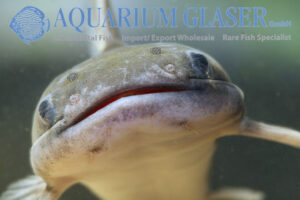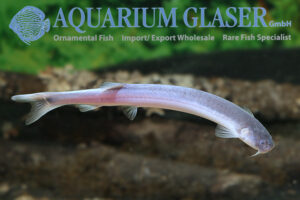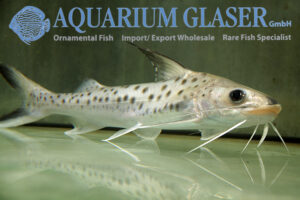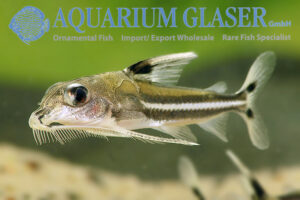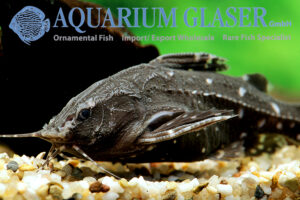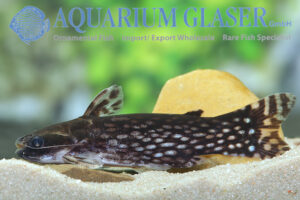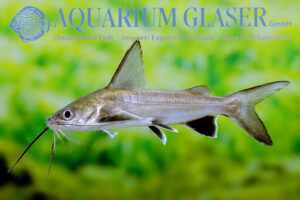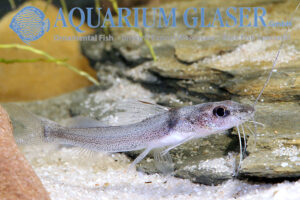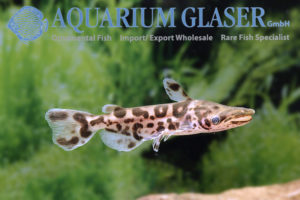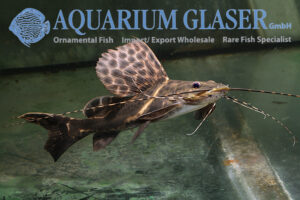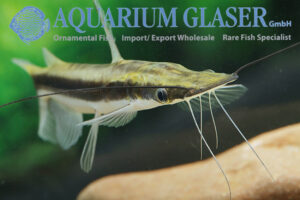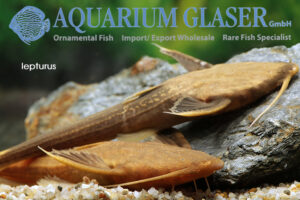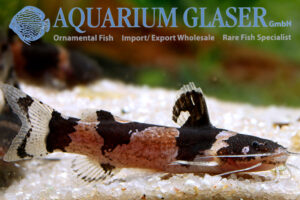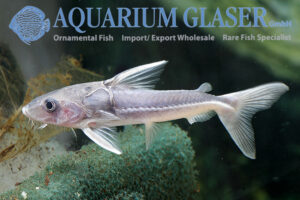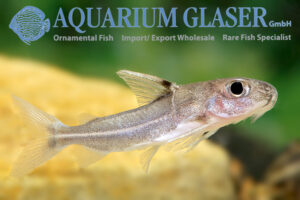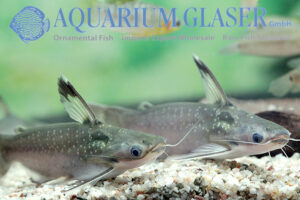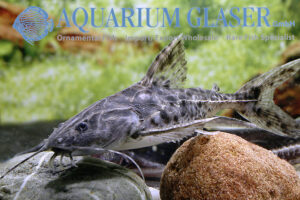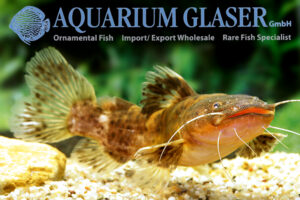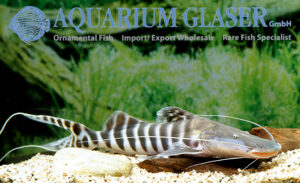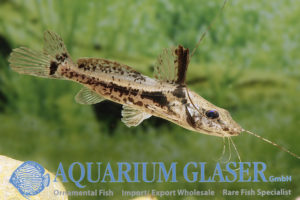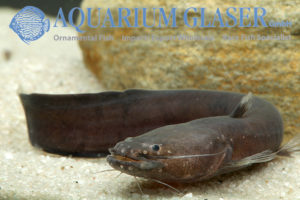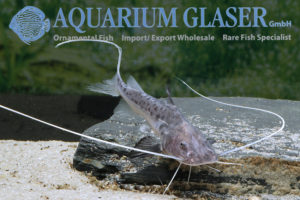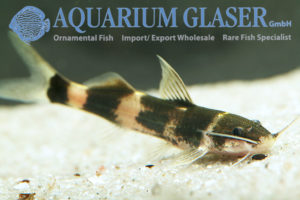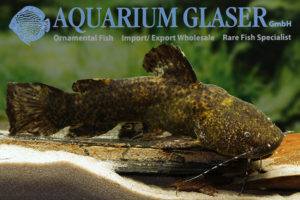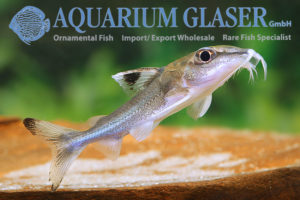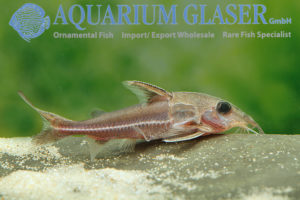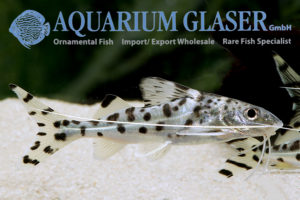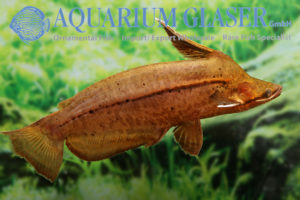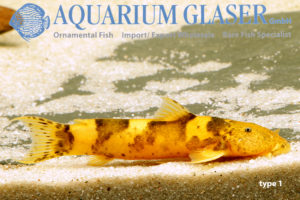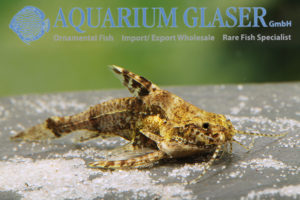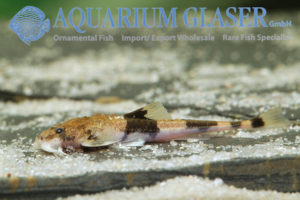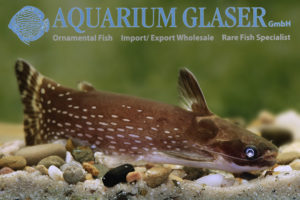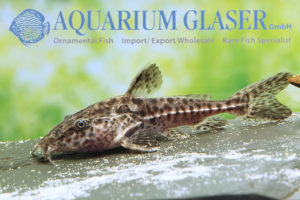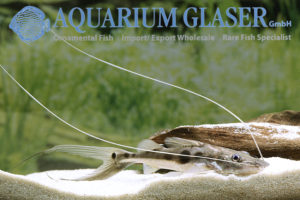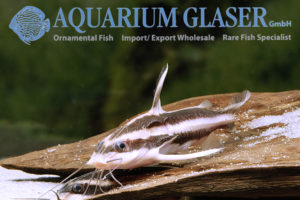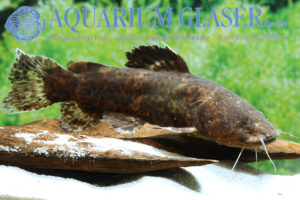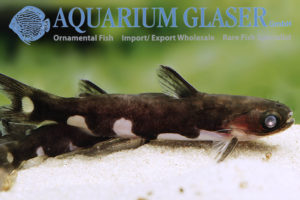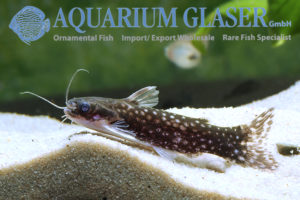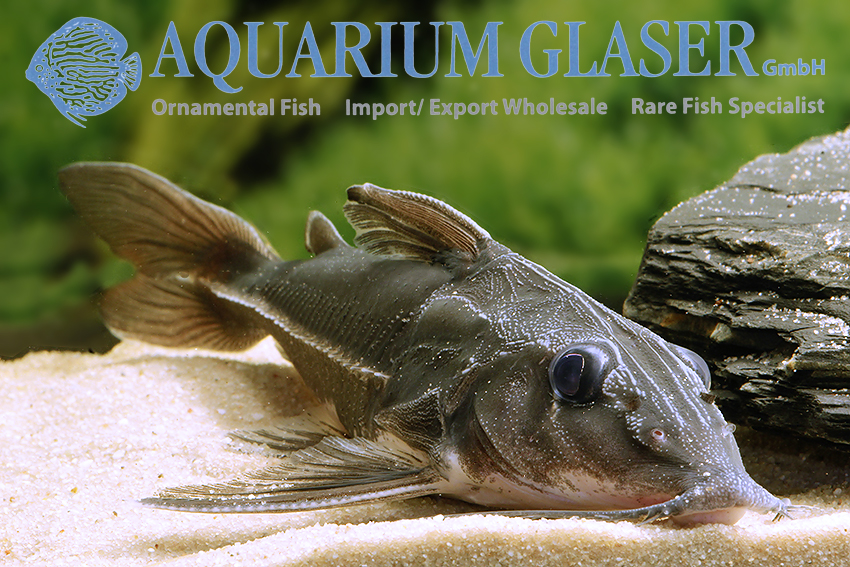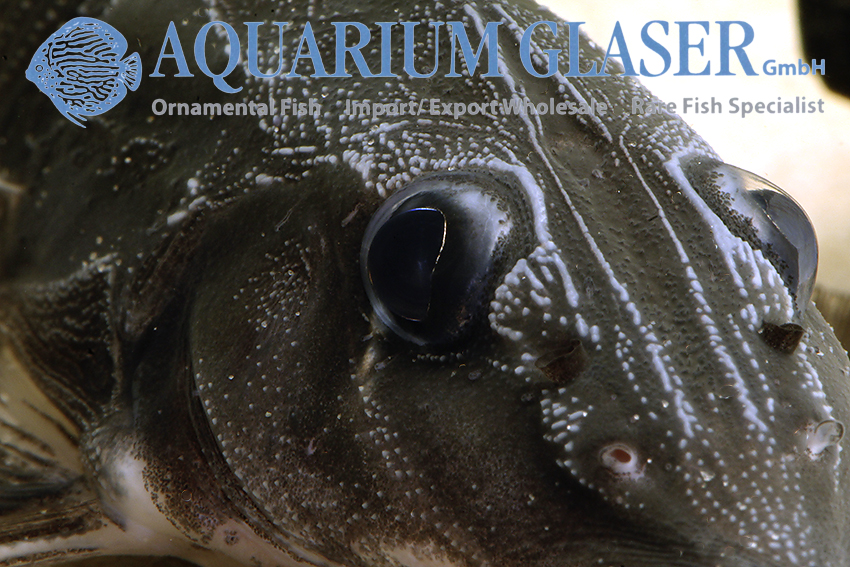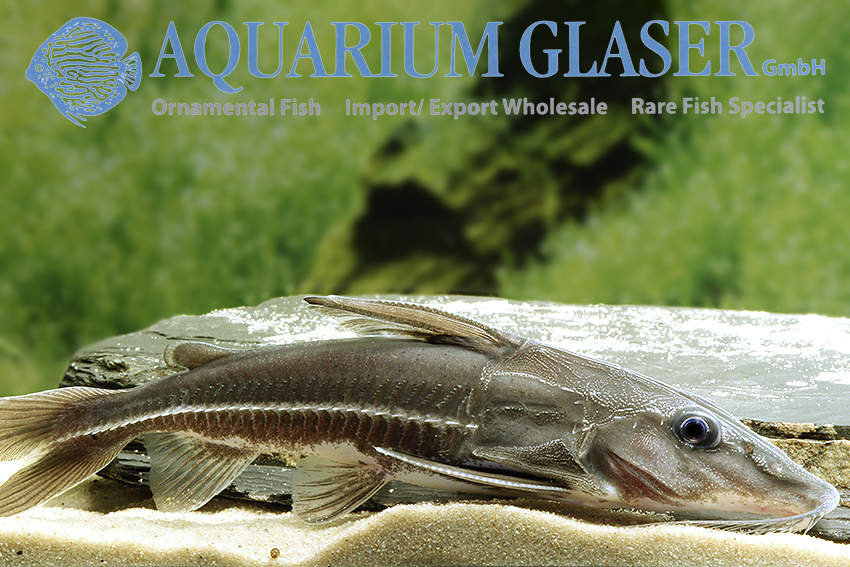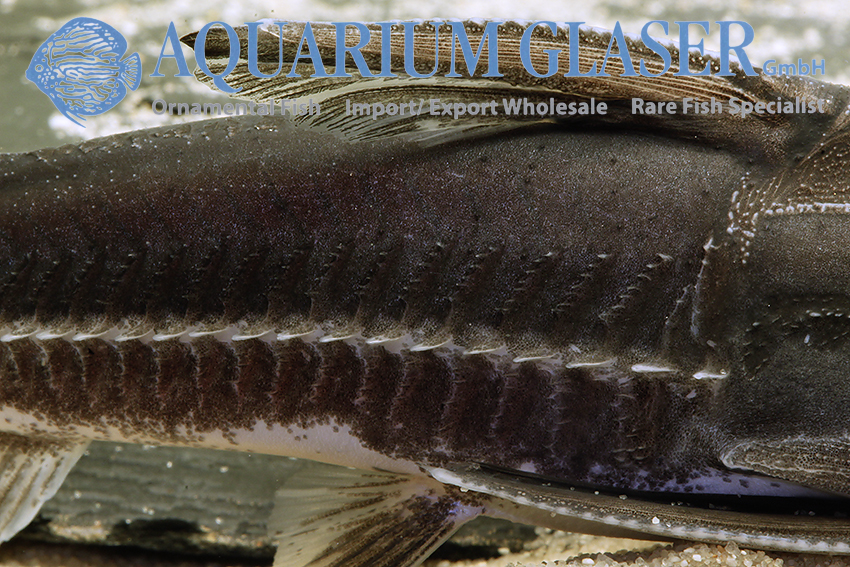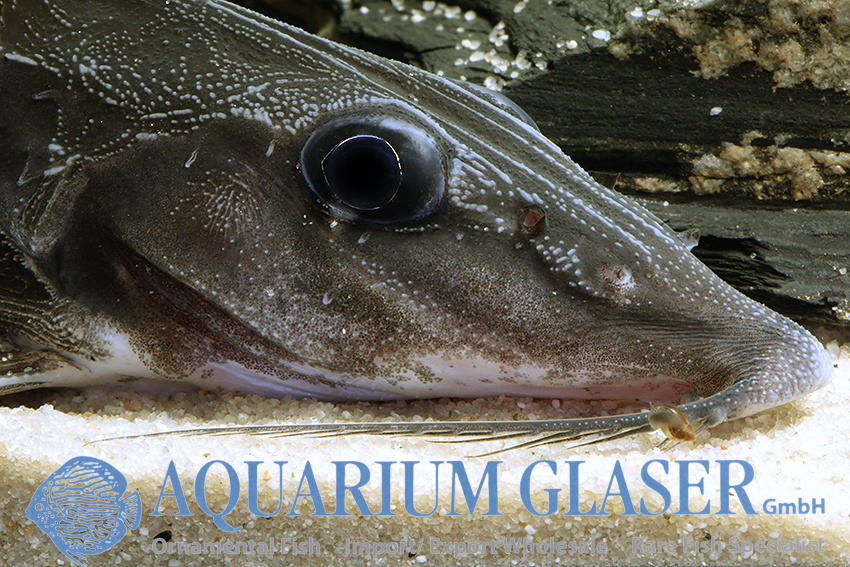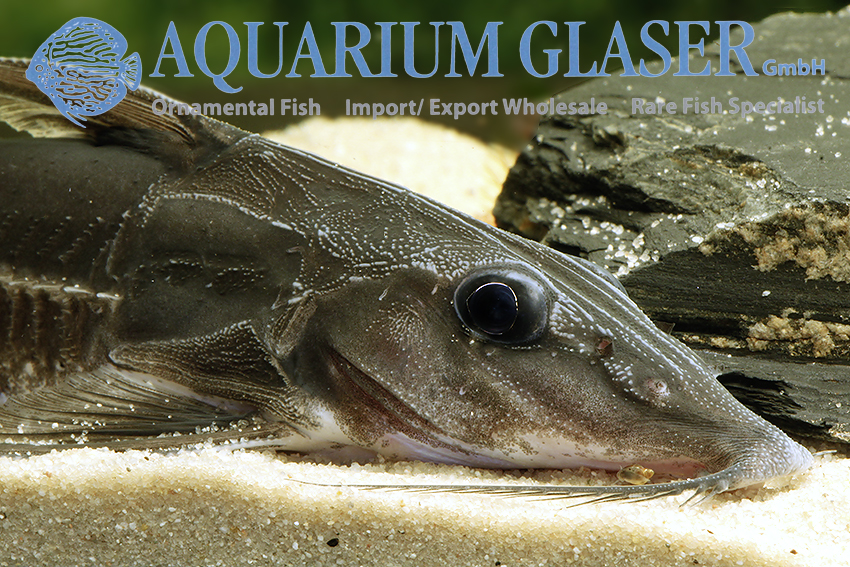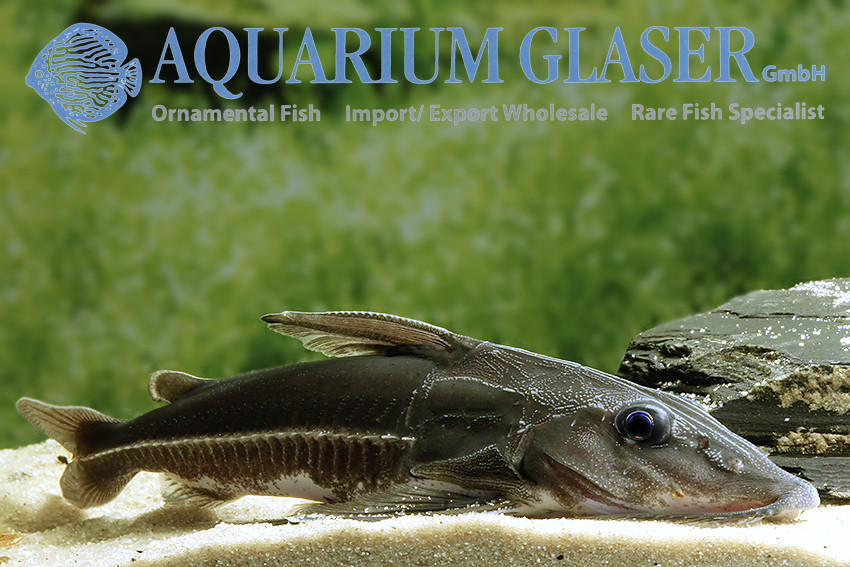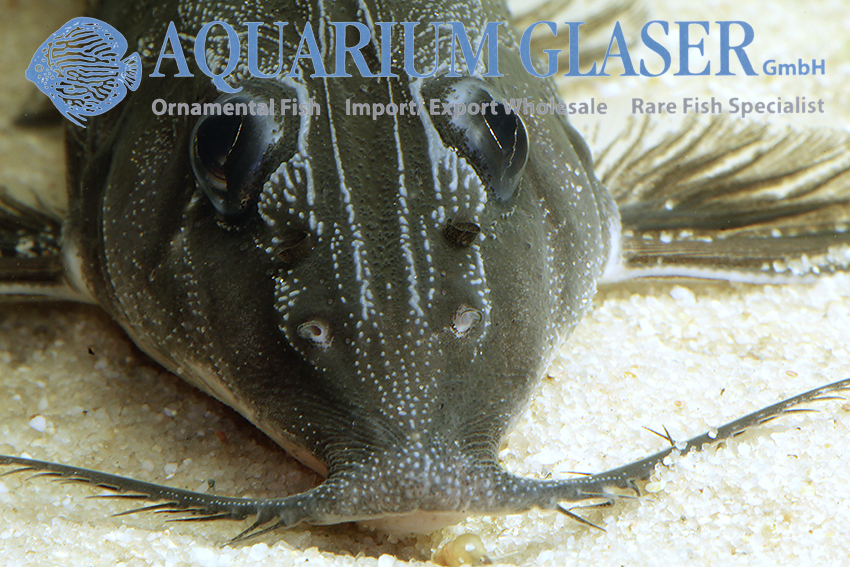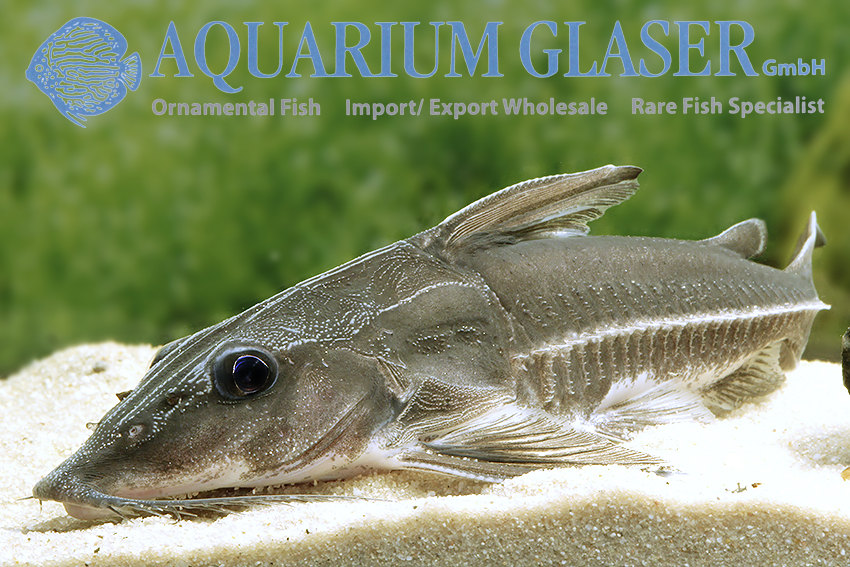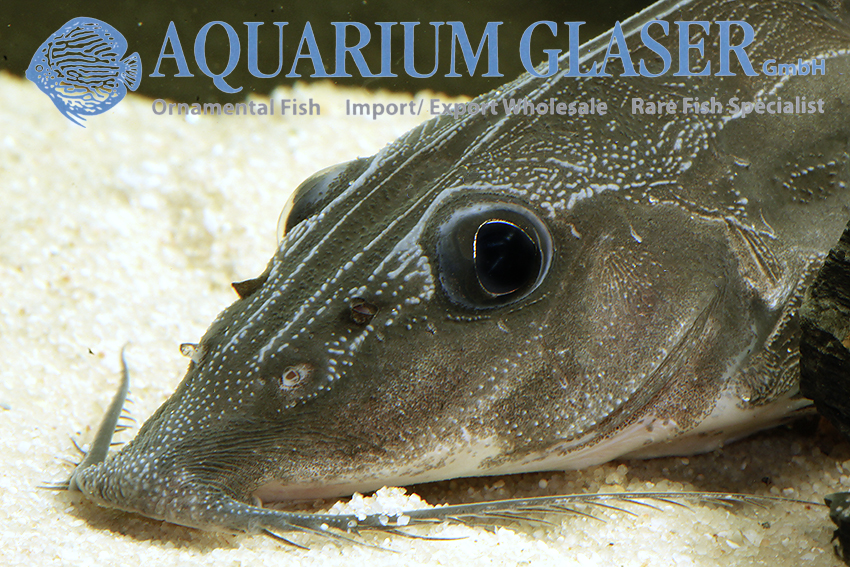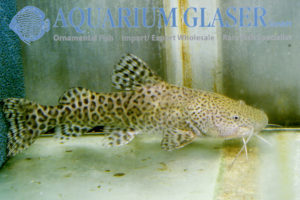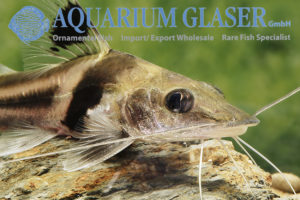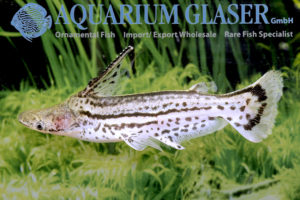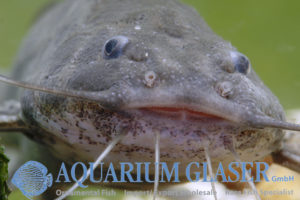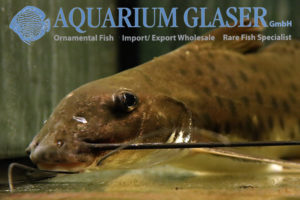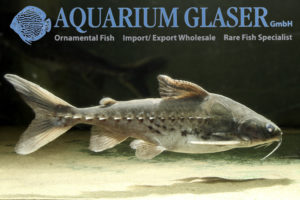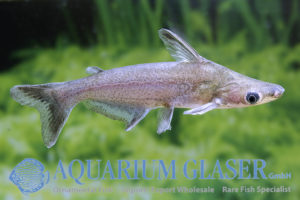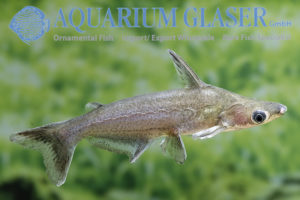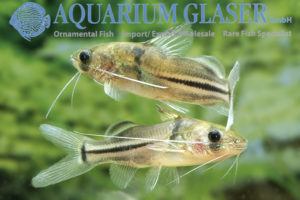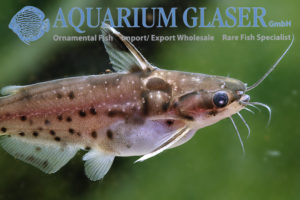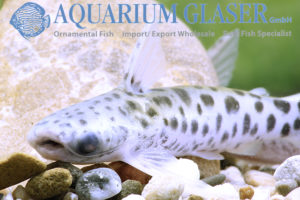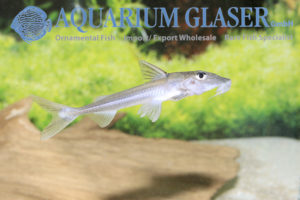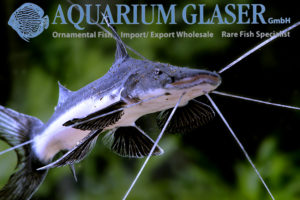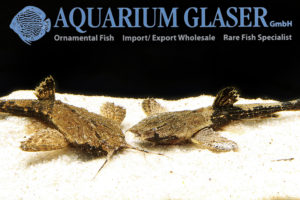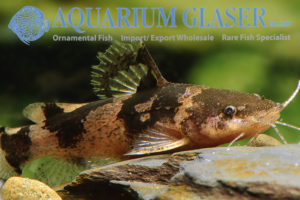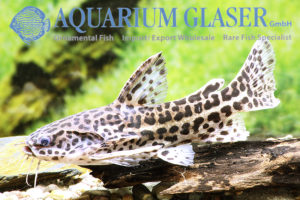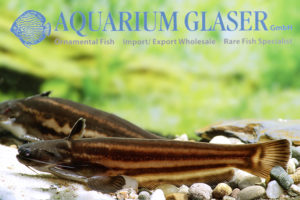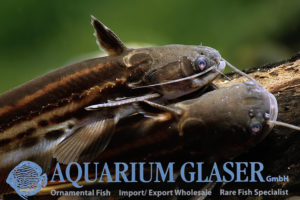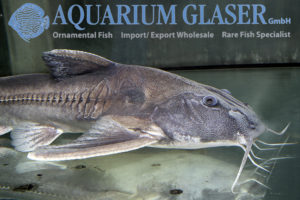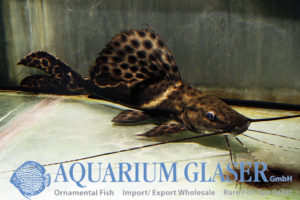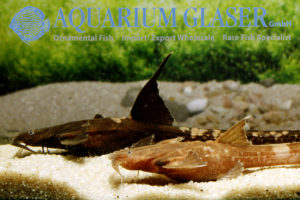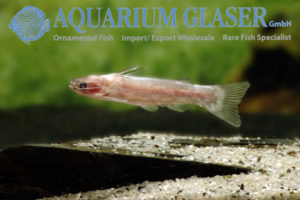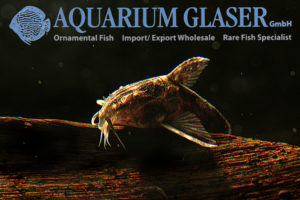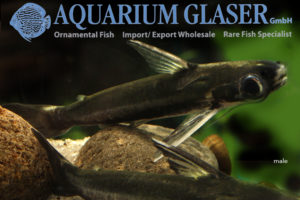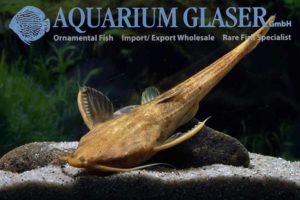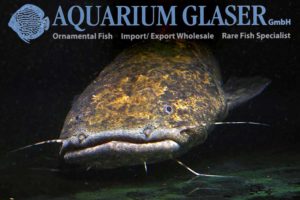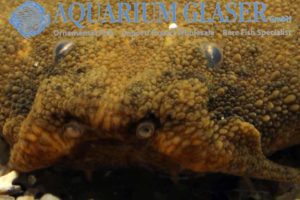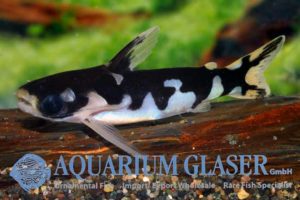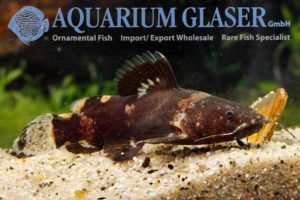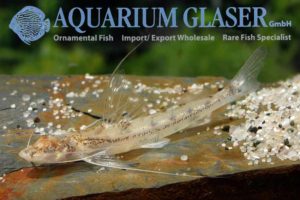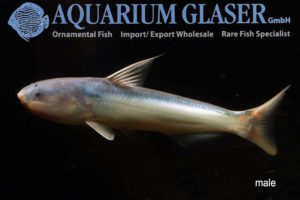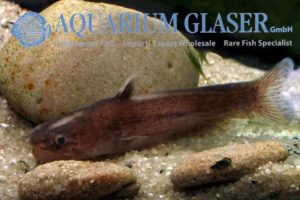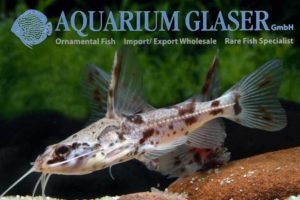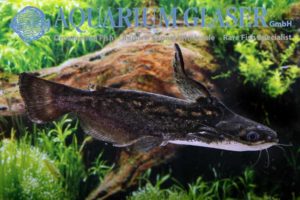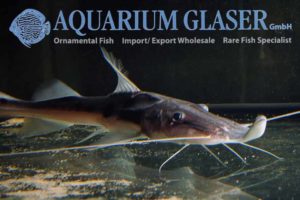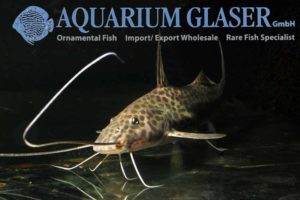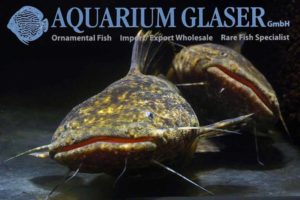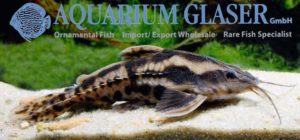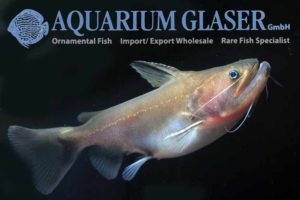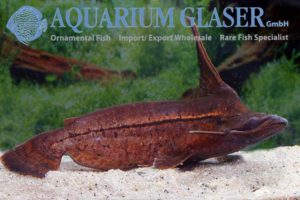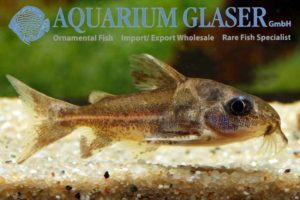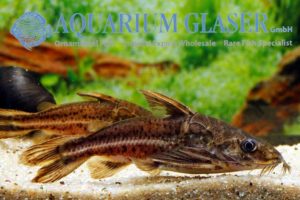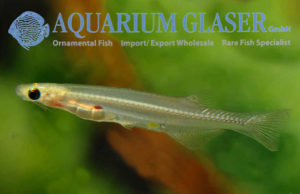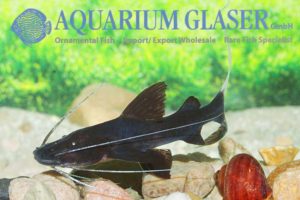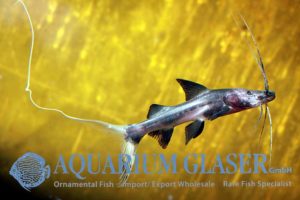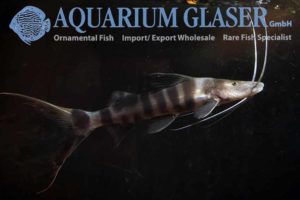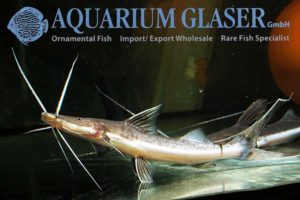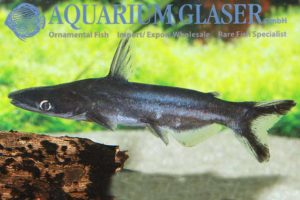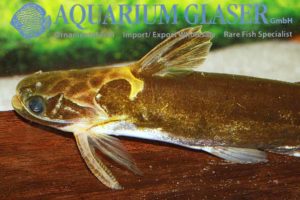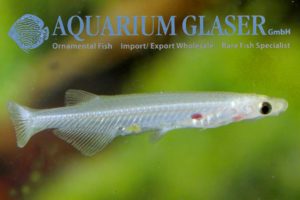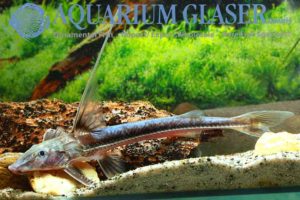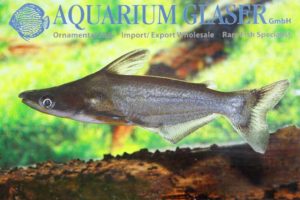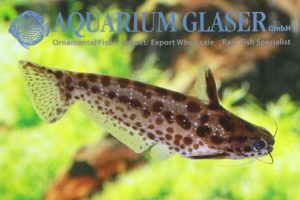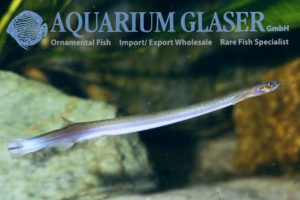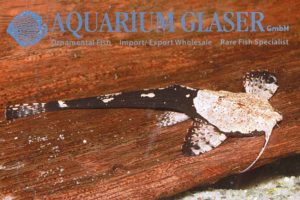We just received one of the very rare imports of a very peculiar representative of the Auchenipteridae (driftwood catfish): Tocantinsia piresi. These catfish were first discovered in 1974 in the Rio Tocantins near Porto National in the state of Goiás in Brazil. Because they did not fit into any known genus, Mees described them as […]
10c. Catfishes: remaining catfish from South America (127)
-
-
Pareiodon cf. microps
The parasitic catfish of the subfamily Stegophilinae within the pencil catfish (Trichomycteridae) are famous and notorious as “Candirus”. They often specialize in blood as food and swim like little vampires into the gill cavity of large catfish, where they bite into a blood vessel and pump themselves full of the red elixir of life. Apparently […]
-
Platynematichthys notatus
Platynematichthys notatus is one of the extremely rare species on the ornamental fish market. There is only one species of the genus, but it is widely distributed in the Amazon and Orinoco river systems (Bolivia, Brazil, Ecuador, Colombia and Venezuela). This fish is usually only caught in the strong current, oxygen-rich areas of the main […]
-
Leiarius marmoratus ( = L. longibarbis?)
There are two species of catfish in South America that look confusingly similar: Leiarius marmoratus, which the Indians call “Achara” and Leiarius (formerly: Perrunichthys) perruno. Both species grow to around 60 cm in length and have the same leopard pattern and long, ringed barbels. However, there is an easily recognizable difference: Leiarius marmoratus has 10-11 […]
-
Tenellus trimaculatus
From Peru we receive this nice catfish, which can be recognized by its species-typical pattern: A black spot at the base of the dorsal fin, two at the middle base of the caudal fin. The species name also refers to this (trimaculatus = with three spots). The peaceful animal becomes about 10 cm long. Its […]
-
Agamyxis pectinifrons
If you are looking for a long-lived, extremely robust, pretty and peaceful fish, Agamyxis is the right fish for you. Although these virtually indestructible spiny catfish grow relatively large at up to 15 cm in total length, they are absolutely peaceful and require so little movement due to their well-kept phlegm that they can live […]
-
Tatia intermedia
The closer relatives of Tatia are quite well known aquaristically, as several species have proven to be easy to keep and breed. The attractive coloration of some species makes up for the fact that these animals are rarely seen during the day. They only leave their hiding places at feeding times. The following applies to […]
-
Ariopsis simonsi (formerly Arius jordani or Hexanematichthys seemanni)
The Colombian shark is a wanderer between worlds. It spends its childhood in fresh water, adults live in the sea. The nutrient-rich brackish water zones of the estuaries are particularly favorable habitats for specimens that have outgrown their infancy. These catfish, which belong to the Ariidae family of around 150 species, only have their name […]
-
Pimelodella sp. Ventuari
The genus Pimelodella comprises 103 described species, of which 81 are currently considered valid. The size of the Pimelodella species is between 7 and 30 cm. So no species is really huge. The genus is almost exclusively South American, with only one species reported from Central America (Costa Rica and Panama). Identification of the species […]
-
Ageneiosus inermis
Already in 1766 this catfish was described by Linné. It is one of the most widespread species in South America. It has been reported from Argentina, Bolivia, Brazil, Paraguay, Ecuador, Peru, French Guiana, Guyana, Suriname, Uruguay, Colombia and Venezuela. In the course of the centuries many synonyms accumulated: 12 times this species was described under […]
-
Leiarius pictus
Leiarius pictus is one of the most attractive predatory catfish of all. The large, sail-like dorsal fin in combination with the light-colored band that starts at the base of the dorsal fin and runs diagonally backwards to the belly make it unmistakable. The species is extremely widespread in South America. It has been reported from […]
-
Sorubim lima
The large-sized species of the spiny catfishes (Pimelodidae) belong as adult fishes to the desired food fishes and not less desired species for fans of predatory catfishes with giant aquariums. As juveniles, these animals often look completely different and have, for example, absurdly long fin processes. The Shovelnose catfishes of the genus Sorubim are with […]
-
Xyliphius cf. lepturus and X. cf. melanurus
Once again we succeeded in importing some specimens of these strange, naturally almost blind banjo catfish, this time from Colombia. For our first import and further information see here: https://www.aquariumglaser.de/en/10-catfishes/10c-catfishes-remaining-catfish-from-south-america/xyliphius-cf-lepturus/ This time there are apparently two species in the import. Unfortunately, only one specimen probably belongs to the species Xyliphius melanopterus, recognizable by the light […]
-
Microglanis “poecilus”
The genus Microglanis consists of small to very small catfish with a maximum length of between 2.5 and 8 cm, depending on the species. All species come from South America. Until 1950, only 6 species were differentiated; currently the number of species is 30, with 17 species alone being described after the year 2000. Only […]
-
Nemadoras elongatus
The thorny catfish are a very interesting and diverse group of catfish. Once again we were able to import the slender species Nemadoras elongatus from Peru, which can reach a total length of around 12-15 cm. At first glance, the fish are very reminiscent of the Hassar species, which they also resemble in terms of […]
-
Tenellus leporhinus
The thorny catfishes of the genera Doras, Hassar, Hemidoras, Leptodoras, Nemadoras and Tenellus look quite similar at the first glimpse and have often been confused with each other in the past, both in scientific and aquarium literature; accordingly, there are always small question marks behind the identification of rarely imported species. From Colombia we have […]
-
Auchenipterichthys coracoideus (formerly: A. thoracatus)
A few decades ago, the Zamora catfish was the most commonly imported driftwood catfish. At that time it was identified as Auchenipterichthys thoracatus. It was not until 2005 that it was discovered that although the species A. thoracatus exists, it is not identical to the Zamora catfish. Its correct name is Auchenipterichthys coracoideus. While A. […]
-
Pterodoras granulosus
The Thorny Catfishes (Doradiae) are a small family of exclusively South American catfish. Currently 41 genera containing 127 species are known, but continuously new species become discovered. The largest species attain a maximum length of more than 100 cm. The world record for Opsodoras niger is 120 cm and a weight of 20 kg. The […]
-
Batrochoglanis sp. I
From two different suppliers, one from Peru and one from Colombia, we have received a catfish of the genus Batrochoglanis, whose identification to species level is not possible according to the publications to date. Representatives of the genus Batrochoglanis are not difficult to recognize as such; typical of the genus is the shape of the […]
-
Calophysus macropterus
The predatory catfish Calophysus macropterus belongs to the medium-sized species of the Pimelodidae (antenna catfish), the largest representatives of which can reach a length of around 2 meters. The largest Calophysus measured to date (there is only one accepted species, C. macropterus) is said to have been approx. 60 cm long, but animals as long […]
-
Brachyplatystoma tigrinum (formerly: Merodontotus tigrinus)
It’s hard to believe, but this striking and large catfish – the species reaches a final length of approx. 85 cm – which is also widely distributed in Amazonia (Ecuador, Peru, Colombia, Bolivia, Brazil) was only discovered in 1981! It was described in the genus Merodontotus, which was created especially for it, but is now […]
-
Goeldiella eques
From Peru we could import this interesting catfish, which is only rarely available, although the species has a very wide distribution in South America. The up to 30-35 cm long fish has already been reported from the whole Amazon region and from the Guyana countries. Zoologically Goeldiella eques belongs to the family Heptapteridae; there are […]
-
Myoglanis koepckei
This small catfish, unique in its combination of characteristics, originates from Peru. There it was collected (scientifically) for the first time in 1984 in a small tributary of the Rio Nanay, which had sandy bottom covered with debris (probably dead wood, dead leaves etc). The scientific description was then in 1999 as Myoglanis koepckei. In […]
-
Brachyplatystoma capapretum
The genus Brachyplatystoma is called “Goliath Catfishes” in English, because some of its species belong to the largest freshwater fishes at all: up to 3.6 m length are given in literature! In South America they are ubiquitous and important food fish, of which more than 30,000 tons are consumed annually. Nevertheless, distinguishing the species is […]
-
Cetopsorhamdia molinae
For the first time we could import this cute dwarf catfish from Peru. In the scientific literature the maximum size is given as 3,6 cm (without caudal fin). It is absolutely incomprehensible, why this attractively striped fish (however, there are numerous individual colour morphs from banded to almost completely black, some animals are also of […]
-
Batrochoglanis villosus
From the Rio Xingu in Brazil we have received frog catfishes, which are assigned to the species Batrochoglanis villosus. Batrochoglanis was previously placed with Pseudopimelodus. More recent work has divided the frog catfishes into a whole series of genera, which makes it difficult to see through, especially since many species from different genera look darn […]
-
Hassar orestis
From Venezuela we could import this pretty and lively thorny catfish. The species is widespread in South America and reaches a length of about 18 cm. In behavior these diurnal catfishes resemble the Corydoras species; however, they are much more active swimmers and constantly on the move in the aquarium. They are peaceful, sociable animals. […]
-
Hemidoras boulengeri
For a long time there were very different ideas among ichthyologists about the generic classification of the thorny catfishes. Aquaristically mainly the genera Doras, Hassar, Hemidoras, Leptodoras, Tenellus and Anduzedoras cause classification problems due to their similar appearance and relatively few useful color characteristics. Fortunately, this has little practical impact because they are all fairly […]
-
Pimelodus pictus
Among the large antenna catfishes (Pimelodidae) Pimelodus pictus belongs to the dwarfs. Scientifically proven are 11-12 cm length, but in the aquarium, where these fish can become very old, also 25 cm are said to have occurred. In nature these fishes probably do not live longer than 2-3 years, the keeping record in the aquarium […]
-
Tetranematichthys wallacei
At present three species of the strange genus Tetranematichthys are distinguished. None of them comes more frequently or even regularly into the trade, because their hidden way of life makes their catch a pure matter of luck. So we were particularly pleased to be able to import the species T. wallacei from Colombia. We are […]
-
Astroblepus from Colombia
The L-catfishes or Loricariidae from South America belong to the most popular and most desired catfishes for the aquarium. However, even experienced aquarists have hardly ever had the opportunity to see a living representative of the genus Astroblepus. It is the only genus of the family Astroblepidae, the closest relatives of the Loricariidae, distinguished from […]
-
Physopyxis lyra
Although this dwarf among the thorny catfishes – it only grows to about 3 cm in length – was scientifically described as early as 1872, it was completely unknown to aquarists until a few years ago. This is a pity, because they are droll, very interesting small catfishes, which are also suitable for small and […]
-
Hoplomyzon sexpapilostoma
Within the banjo catfish family (Aspredinidae), there is a group of dwarfish small species (called the tribus Hoplomyzontini) divided into four genera: Ernstichthys, Hoplomyzon, Dupouyichthys and Micromyzon. They grow only 2-3 cm long. In nature they live buried in fine sand (at least during the day). Most species prefer the deepest channels of medium to […]
-
Tatia intermedia
From Peru a larger number of Tatia reached us thanks to this import we can now solve an more than 10 year old puzzle. In 2011 we received from this country monochrome Tatia, which could not be assigned to any known species (https://www.aquariumglaser.de/en/fish-archives/tatia_sp_tahuayo_river_en/). Now it is clear: it is a monochrome color variant of T. […]
-
Oxydoras niger
With a maximum length of 1 meter Oxydoras niger belongs to the largest species of thorny catfishes. Nevertheless it is a very peaceful species and therefore quite attractive for owners of very large aquariums, show aquariums and zoos. Fully grown these fishes are uniformly black (this is exactly what the species name “niger” = black […]
-
Platysilurus mucosus
Predatory catfishes exude a special fascination to many a catfish lover. Unfortunately, many species simply become too large for permanent care in a normal sized home aquarium. However, there are also species that grow to only 20-30 cm in length and for which it is therefore not necessary to flood the entire basement to meet […]
-
Platydoras armatulus
The snarling zebra catfish – this is how Platydoras armatulus could be popularly called. However, it is actually called the striped raphael catfish. All spiny catfish can make distinct growling or croaking sounds when taken out of the water. They vibrate their whole body. Presumably this serves as a defense against enemies. But even without […]
-
Batrochoglanis sp. Venezuela
Something is happening with the South American bumblebee and frog catfishes! In former times they were assigned to the long-whiskered catfishes (Pimelodidae), today they are placed in an own family, the Pseudopimelodidae. Often in the trade are the striking yellow-black marked, only 3-8 cm large South American bumblebee catfishes (Microglanis, 23 species), and the similarly […]
-
Tatia musaica/ Centromochlus musaicus
When the first black and white “Tatia” appeared in the ornamental fish trade some years ago, they were celebrated as a sensation. (see https://www.aquariumglaser.de/en/fish-archives/centromochlus_sp_ninja_en/ and https://www.aquariumglaser.de/en/fish-archives/tatia_musaica_en/). We identified these fish, which originated in Brazil, as Tatia musaica. In 2017, a team of scientists published a study on Centromochlus species and described the species previously known […]
-
Tatia galaxias
The cute Tatia catfishes are quite popular in the hobby. Keepers put up with the fact that you can hardly see them outside feeding times, because they are extremely addicted to hiding. But they make up for it with their pretty coloration and good breedability. Tatia galaxias comes from the Orinoco river basin in Colombia […]
-
Zungaro zungaro
The catfish Zungaro zungaro belongs to the largest catfish species of South America. There were all kinds of debates about its name, for a long time it sailed under Pseudopimelodus zungaro or Paulicea luetkeni. Because of its gigantic size (length up to 140 cm, weight up to 50 kg) the species is difficult to study […]
-
Pimelodus ornatus
One of the most attractive large catfishes is Pimelodus ornatus, which is common in large parts of tropical South America. It is reported from the big rivers Amazonas, Orinoco and Parnaná, in addition the Guyana states. Maximum size reported is 38.5 cm (excluding caudal fin). The beautiful and lively fish is notorious for its venomous […]
-
Ageneiosus magoi
Males of all dolphin catfishes (Ageneiosus) develop huge dorsal fin spines and a penis-like mating organ at spawning time, also strange tooth-like looking papillae on the posterior margin of the upper jaw. They use the dorsal fin spine to clamp females for mating, and fertilization occurs internally. After spawning, the dorsal fin spine is shed […]
-
Wertheimeria maculata
Wertheimeria maculata belongs to the strangest thorny catfishes. You don’t see this on the relatively inconspicuous juveniles with their 6-8 cm length, but it is nevertheless so. The first thing that catches your attention is the really high price that is demanded for them. This is due to the fact that these fish are local […]
-
Pimelodina flavipinnis
We are proud to present this unusual first import. The rarity of this pretty large catfish in the hobby stands in strong contrast to the fact that it was scientifically described as early as 1876, is widespread (our animal comes from the Rio Negro in Brazil, but it also exists in the Rio Madeira, in […]
-
Lithodoras dorsalis
The genus Lithodoras belongs to the thorny catfishes (Doradidae). There is only one species scientifically described, which has its distribution in South America: L. dorsalis, which inhabits the Amazon basin; in addition, the species was reported from a creek near Cayenne (French Guiana), but the latter occurrence still needs confirmation. The maximum length of L. […]
-
Sorubim lima
The large-sized species of the spiny catfishes (Pimelodidae) belong as adult fishes to the desired food fishes and not less desired species for fans of predatory catfishes with giant aquariums. As juveniles, these animals often look completely different and have, for example, absurdly long fin processes. The Shovelnose catfishes of the genus Sorubim are with […]
-
Tympanopleura cryptica
For the first time we could (recognized) import this dolphin catfish from Peru. The small species (the biggest scientifically known animal had a standard-length – therefore without tail fin – of barely 8,5 cm) occurs in the area of the upper Amazon, where the river is still called Solimoes. Tympanopleura cryptica was described scientifically only […]
-
Tympanopleura cryptica
For the first time we could (recognized) import this dolphin catfish from Peru. The small species (the biggest scientifically known animal had a standard-length – therefore without tail fin – of barely 8,5 cm) occurs in the area of the upper Amazon, where the river is still called Solimoes. Tympanopleura cryptica was described scientifically only […]
-
Brachyrhamdia meesi
The genus Brachyrhamdia includes only five described species, another one, that is still scientifically undescribed, was imported over 10 years ago as accidental catch, since then, one heard nothing more of it. Brachyrhamdia are relatively small-growing catfish. Brachyrhamdia meesi comes from Brazil and grows to about 8 cm in length. Like all species of the […]
-
Auchenipterichthys punctatus
It was believed for quite a long time that the genus Auchipterichthys would contain only one or two, very far spread species. In 2005 Ferraris, Vari, and Raredon revised the genus and could show that in reality four different species are involved. The species that was thought so far to be the most common in […]
-
Balroglanis schultzi (formerly Centromochlus s.)
The driftwood catfishes enjoy an increasing popularity, since it succeeds regularly to reproduce them. All species have – as far as known – an internal fertilization, the females spawn later without the presence of a male. Most driftwood catfishes are active at night or twilight. Many species are known to hunt land insects that have […]
-
Leptodoras cf. cataniai “Rio Nanay“
We receive only very rarely imports of one of the unusual and stress-prone Leptodoras species. These thorny catfish are extraordinarily elongated and apparently live in flowing waters, while many other thorny catfish – think of the Platydoras, Agamyxis etc. which are common in the hobby – are more at home in dead wood or leaves […]
-
Brachyplatystoma platynemum
From Peru we have received some specimens of this very rarely imported catfish. The animals are in top condition and currently 10 – 12 cm long. Brachyplatystoma platynemum used to be placed in a separate genus, Goslinia, which is now a synonym for Brachyplatystoma. B. platynemum is distributed throughout the Amazon and Orinoco region and […]
-
Bunocephalus coracoideus
Banjo catfish (Bunocephalus) are very common in nature. That is why we always have them on offer. Mostly we call them Bunocephalus coracoideus, which may be correct in many cases. But if you look into such a swarm of banjo catfish you will notice that there are always other species in between. Usually they cannot […]
-
Microglanis carlae
Usually the „typical“ catfish with long barbels become quite big and are therefore also called “predatory catfish” in the hobby. The lovers of these animals therefore have really large aquariums to care for their favourite fish. However, there is a species from South America, more precisely from Paraguay, which is truly also suitable for nano […]
-
Ageneiosus lineatus (= sp. III Green Stripe)
Update: es handelt sich um die Art Ageneiosus lineatus Ribeiro, Rapp Py-Daniel & Walsh 2017 The dolphin catfish were only recently revised and divided into two genera: Ageneiosus and Tympanopleura. Tympanopleura are the smaller species. They are characterized by a circular structure immediately behind the edge of the gill cover, which looks like a tympanum. […]
-
Liosomadoras oncinus
The Jaguar catfish (Liasomadoras oncinus) belongs to the rarities in the aquarium. Also in the large museum collections of the world the species is only sparsely represented, so that the knowledge about these animals is small. In the aquarium, they belong to the very sensitive species that only experienced aquarists should dare to approach. The […]
-
Trachelyopterichthys taeniatus
Among the driftwood catfishes are some quite attractive coloured species. This is a bit astonishing, for these catfishes are usually strictly night active and hide during daytimes in caves or crevices. However, well settled animals usually come out of their wholes at feeding times in the aquarium. Trachelyopterichthys taeniatus belongs to the really attractive species. […]
-
Trachelyopterichthys taeniatus
Among the driftwood catfishes are some quite attractive coloured species. This is a bit astonishing, for these catfishes are usually strictly night active and hide during daytimes in caves or crevices. However, well settled animals usually come out of their wholes at feeding times in the aquarium. Trachelyopterichthys taeniatus belongs to the really attractive species. […]
-
Centrodoras brachiatus
In two large specimens (they are currently 20-25 cm long) we have received the extremely rarely imported Centrodoras brachiatus from Peru. The up to 40 cm long catfish are widely distributed in the Amazon system and also occur in Brazil and Colombia. Typical is the form of the lateral bone row, whose shields are very […]
-
Hey, hey, hey, hey, little pirate…
This is the chorus of a Rodgau Monotones´ song about a small employee who breaks out of his hated everyday life and puts on an eye patch to continue living as a pirate in the future. We had to think of this song when a magnificent Leiarius pictus from Peru arrived on Wednesday. The animal […]
-
Platystacus cotylephorus
We received this beautiful banjo cat from Brazil currently. The species represents by far the most desirable member of the family. The fish becomes approximately 30 cm long and thus should be kept in larger tanks. In contrast to most other banjo catfishes – which usually do not move if possible – this species is […]
-
Tatia dunni „White“
We were able to import the wooddrift catfish Tatia dunni for the first time in 2010 (see http://www.aquariumglaser.de/en/fish-archives/tatia_dunni_en/). Animals from this stock were given to one of our breeders, Jürgen Hattenberger. Sadly he died unexpected a few weeks ago. Jürgen was able to establish a breeding stock from the first importation and since then we […]
-
Rhynchodoras woodsi
Only very rarely members of the enigmatic genus Rhynchodoras (family Doradidae) appear in the ornamental fish trade. It is believed that these fish live in the very riverbed where collectors of ornamental fishes usually do not fish at all. All species of Rhynchodoras have a strange appendix on the jaw that looks like a share; […]
-
Centromochlus heckelii
It is a pity that we can offer this interesting driftwood catfish only very rarely and in small numbers. The species has a wide distribution in the Amazon and Orinoco river basins. It attains a maximum length of about 14-15 cm. Our specimens originate from Peru; here is also the type locality for the species.Two […]
-
Xyliphius cf. lepturus
For the first time ever we could import this extremely odd species of banjo catfish. The eyes are reduced to very small, black spots. This is a hint either to a strictly nocturnal way of life or that the fish live burried. We obtained our specimens from Venezuela. Most probably they belong to the species […]
-
Cephalosilurus apurensis
A face that can be loved only by a mother? Far from that! Among the fans of large, predatory catfish Cephalosilurus apurensis is a much sought after species! The fish attains a maximum length of about 30 cm and appears endemic in Venezuela (this means the distribution is restricted to that country). We were able […]
-
Amaralia hypsiura
Banjo catfishes are subjects for lovers of calm fishes. One could also ay: for lovers of phlegmatic fishes. These creatures will not swim even an inch if it is not absolutely necessary. On the other hand they are really odd looking creatures. The strangest looking of this assemblage of strange-looking animals is without any doubt […]
-
Tatia musaica (= Cenromochlus orca)
We were able to import again a small number of the most attractive of all driftwood-catfishes: Tatia musaica, the ninja-tatia. This beautiful fish attains a maximum length of about 5-6 cm. Like all the driftwood catfishes this species also has an internal fertilization. The male´s anal fin is modified for that purpose, similar as it […]
-
Batrochoglanis raninus Dwarf
Batrochoglanis raninus Dwarf The genus Batrochoglanis was formerly placed in Pseudopimelodus. Batrochoglanis can be best distinguished from Pseudopimelodus by the shape of the caudal fin. Pseudopimelodus has a deeply forked caudal fin, Batrochoglanis only a slightly indented one. Currently five species of Batrochoglanis are accepted. We obtain occasionally specimens of that genus from Colombia, which […]
-
Mastiglanis asopos
Catfishes in general often look quite odd. This is for sure true for this dwarf catfish, which was described only in 1994 in a new genus. The maximum length of this fish is about 6-7 cm without the caudal fin. The shape of the body is very elongate. The extremely long pectoral fin rays are […]
-
Cetopsis coecutiens
This species is legend. Cetopsis coecutiens becomes up to 40 cm long and is spread very far over South America – and feared! The animals are merciless hunters. Even when trapped in a fish cast they bite pieces out of their fellow captives. Even attacks on humans are reported. People living along the Amazon river […]
-
Denticetopsis seducta
For the first time ever we could import this dwarf whale catfish from Peru. The maximum length of this tiny species seems to be around 5-6 cm. In contrast to the better known blue whale catfish, Cetopsis coecutiens, which is an aggressive predatory species, all Denticetopsis are competely harmless insectivorous fishes. This species has been […]
-
Amblydoras nauticus
Catfishes have no scales. But many species have bony plates that cover and protect the body. In the family Doradidae these plates are sometimes additionally armored by spines. One of the most common species of Doradidae in Amazonia is the marbled talking catfish, Amblydoras nauticus. The species is not very popular by the natives, because […]
-
Trachelyopterus fisheri
Currently we can offer a very odd species of catfish, namely Trachelyopterus fisheri. Initially this species of driftwood catfish orginates from Colombia where it is found in the system of the Rio Sucio. From that area only very occasionally importations appear. So we are quite happy that we have an adult wild collected male of […]
-
Platystomatichthys sturio
Finally we are able again to offer one of the most bizarre species of predatory catfish of Amazonia: Platystomatichthys sturio. Anyone who sees the fish for the first time will think that the animal is distorted; however, the upturned snout-tip is rather species-specific. Nevertheless the grade of this upturn differs individually and depends also a […]
-
Aguarunichthys torosus
We could import a very special fish for the hobbyists specialized in predatory catfish from Peru: Aguarunichthys torosus. This species has been discovered only in 1986. Isn´t it fascinating that nature has the same solution for totally different species over and under the water? The spotted pattern of A. torosus is very similar to the […]
-
Cephalosilurus apurensis
We have a real delicacy for fans of predatory catfish in small numbers in stock: Cephalosilurus apurensis. This species becomes around 30 cm long. The fish are very hoggish and real personalities! For our customers: the fish have code 214633 on our stocklist. Please note that we exclusively supply the wholesale trade. Text: Frank Schäfer, […]
-
Megalodoras uranoscopus (= irwini)
Currently we have very nice juveniles of this large species (50-70 cm) of thorny catfish from Peru in stock. For our customers: the fish have code 267503 on our stocklist. Please note that we exclusively supply the wholesale trade. Text & photos: Frank Schäfer
-
Asterophysus batrachus
We could import a number of still young, about 5-7 cm long specimens of this unusual catfish from Venezuela. The fish feed readily on feeder fish. Here is the story that belongs to the animals: The Altum-Eater of the Atabapo In the spring of 2004 Aquarium Glaser managed to import for the first time one […]
-
Tetranematichthys wallacei
Currently three different species of the remarkable genus Tetranematichthys are distinguished by scientists. None of them is often imported, because their secretive way of life between dead driftwood makes catching them a pure matter of luck. So we are very glad to have managed the first imporation ever of the species Tetranematichthys wallacei from Venezuela. […]
-
Trachydoras paraguayensis
We have received one more charming species of thorny catfish from Paraguay. T. paraguayensis becomes around 10 cm long and can be kept in the same way as a larger species of Corydoras. This means: a peaceful fish, undemanding regarding food and likes to swim in company of its own kind. For our customers: the […]
-
Ossancora punctata
Despite the facts that this pretty thorny catfish, which we were able to import once more from Paraguay, is known to science since 1855 and has an enormous wide distribution in South America – it is reported from Argentina, Brazil, Bolivia, Colombia, and Peru, where it is found both in white and black water – […]
-
Tridensimilis brevis
Once more we were able to import this charming, tiny, free-swimming dwarf catfish (maximum length: 2-3 cm). This time the fish originate from Paraguay. For more information, please see http://www.aquariumglaser.de/en/news/Tridensimilis_brevis_en/ For our customers: the fish have code 298152 on our stocklist. Please note that we exclusively supply the wholesale trade. Text & photo: Frank Schäfer
-
Brachyplatystoma juruense
We have received once more this rare ctafish from Peru. In the meantime the specimens are perfectly acclimatised. More informations on the fish are available on http://www.aquariumglaser.de/en/news/Brachyplatystoma_juruense_en/ Available in limited numbers only! For our customers: the fish have code 211200 (5-8 cm) on our stocklist. Please note that we exclusively supply the wholesale trade. Text […]
-
Brachyplatystoma juruense
From Peru we received once more juveniles of the fantastic predatory catfish B. juruense. Adults of this species attain a maximum length of around 60 cm and have a very nice, zebra-like striped pattern. The coloration of the body of the juveniles is very variable. There do exist spotted ones, striped ones or even uniformly […]
-
Brachyplatystoma juruense
This species of catfish is a predator and becomes easily longer than 60 cm. So it is suited only for specialized aquarists and public aquaria. Our current importation from Peru contains one specimen that is even as a youngster very attractive colored.
-
Brachyplatystoma platynemum (= Goslinia platynema)
We received some specimens of this extremely rare catfish from Peru. The animals are in perfect condition and currently 14 – 16 cm long. For our customers: the fish have code 254783 on our stocklist. Please note that we exclusively supply the wholesale trade. Text & photos: Frank Schäfer
-
Ageneiosus sp. III GREEN STRIPE
We received a very limited number of this dolphin cat from Peru. The species may reach about 20 cm in total length, currently the fish are 7-10 cm long. For our customers: the animals have code 203264 on our stocklist. Please note that we exclusively supply the wholesale trade. Text & photos: Frank Schäfer
-
Tatia sp. Tahuayo River
We received this pretty new species currently from Peru in small numbers. The Tahuayo river, a tributary of the Amazon river, was given as collecting site. Our specimens are 10-12 cm long. They cannot be assigned for sure to any known species. Obviously it is a close relative of Tatia nigra from the central Amazon […]
-
Tridensimilis brevis
Currently we received the cute freeswimming dwarf glass cat Tridensimilis brevis from Peru. The fish attains a maximum length of 3 cm. It belongs to the notorious candiru relationship, but is no blood sucker at all. This tiny catfish is that translucent that it is possible to observe the way of the food from the […]
-
Leptodoras juruensis
Once more we were able to import the very rare, bizarre Leptodoras juruensis from Peru in a very limited quantity. For our customers: the fish has code 266065 on our stocklist. Please note that we exclusively supply the wholesale trade.
-
Ageneiosus cf. atronasus
For the first time ever we received now this interesting doplhin catfish from Peru. In contrast to many of its congeneers this species stays relatively small and reaches only 12 cm in total length. Thus it is suitable also for normal sized home aquaria. However, one should always keep in mind that these catfishes are […]
-
Trachelyichthys sp. Jutai
We currently received this cute driftwood catfish from Brazil. Initially we thought all fish of the import would belong to the same, highly variable coloured species; but in the meantime we found that in fact two species were involved, namely T. sp. “Jutai” and Auchenipterichthys punctatus. Most probably Trachelyichthys sp. “Jutai” becomes as big as […]
-
Plectrochilus erythrurus
We managed to import a few specimens of the exteme rarely imported, blood sucking Candiru-catfish species Plectrochilus erythrurus, which have currently a length of 12-15 cm, from Peru. For our customers: the fish have code 280754 on our stocklist. Please note that we exclusively supply the wholesale trade. Text & photos: Frank Schäfer
-
Pterobunocephalus depressus
This is by far the most attractive species of all banjo cats – and the rarest. We recently received the fish for the first time from Peru. It is also one of the most variably coloured species of banjo cat. Most specimens have a sharp black-and-white contrasting pattern, being white anterior and black posterior. But […]
Nemadoras humeralis
The thorny catfishes are a very interesting and diverse group of catfishes. We were able to import from Peru the species Nemadoras humeralis, which can reach a total length of about 15-20 cm. At first sight the fishes remind very much of the Hassar species, which they also resemble in behavior. They are peaceful schooling fish that move around a lot and appreciate some current in the aquarium.
Nemadoras are omnivores that can be fed on all common aquarium fish foods, although the emphasis should clearly be on a meaty diet. Water composition plays a minor role in their care. You can maintain the animals in any tap water.
The aquarium for Nemadoras should have plenty of free swimming space. Plants will not be damaged, but with very dense plant growth there is a risk that the fish will become entangled in the underwater plants. Nemadoras are ideal community fish for larger aquariums with tetras etc.
For our customers: the fish have code 272484 on our stock list. Please note that we supply exclusively to wholesalers.
Text & Photos: Frank Schäfer
Extraordinary rare thorny catfish from Peru
The
Thorny Catfishes (Doradiae) are a small family of exclusively South
American catfish. Currently 41 genera containing 127 species are known,
but continuously new species become discovered. The largest species
attain a maximum length of more than 100 cm. The world record for
Opsodoras niger is 120 cm and a weight of 20 kg. The smallest species –
Physopyxis lyra – becomes only 3.5 cm long. Most species attain a
maximum length between 10 and 20 cm.
We currently have some very rare species from Peru in our stock which we want to introduce to you here.
Megalodoras uranoscopus
is one of the large species. It can become about 50 cm long. Juveniles are pretty fish and now and then imported (see http://www.aquariumglaser.de/en/news/Megalodoras_uranoscopus_irwini__en/).
Currently we have three mighty big ones of 25-30 cm length in stock. A
well known synonym of the species is Megalodoras irwini. Codenumber on
our stocklist: 267526



Nemadoras elongatus
becomes only 12 cm
long. The peaceful animals love to swim in schools. Males seem to stay
about one third smaller than the females. Sadly almost nothing is knowns
regarding the breeding biology of doradids which is also true for this
species. Code: 272482







Hemidoras morrisi
resembles Nemadoras
elongatus in respect of coloration, but is much more elongate, has a
stronger sculpure of the bony ridges and the dorsal spine is heavily
serrated on both sides, while it has a serration only backwards in N.
elongatus. H. morrisi becomes about 15 cm long and is rather night
active. For us this is the first importation of the species. Code:
257803





Pterodoras granulosus
is a large species again, which can become around 70 cm
long. However, we obtained juveniles of 6-7 cm. This species is as
peaceful as any species of thorny catfish, but one should keep in mind
that the fish has a large mouth and smaller fish will vanish there of
course… Code: 286582


Please note that we exclusively supply the wholesale trade.
Text & photos: Frank Schäfer
Three rare catfish-species from Paraguay
We received three very rare and interesting species of catfish from Paraguay:

The pretty cory Corydoras diphyes, the dwarf sucker Otocinclus mimulus that lives along with C. diphyes and imitates that species, and the charming dwarf sucker Hisonotus nigricauda. We already have pages on our site, so please follow the links given here:

Corydoras diphyes: http://www.aquariumglaser.de/en/fish-archive/corydoras-en/Corydoras_diphyes_en/


Otocinclus mimulus: http://www.aquariumglaser.de/en/news/otocinclus_mimulus_en/

Hisonotus nigricauda: http://www.aquariumglaser.de/en/fish-archive/catfish-en/loricariidae-en/Hisonotus_nigricauda_en/


For our customers: the animals have code 227563 (Corydoras diphyes, lg-xlg), 273994 (Corydoras mimulus, xlg), and 258433 (Hisonotus nigricauda, lg) on our stocklist. Please note that we exclusively supply the wholesale trade. The photos show animals from our current stock.
Text & photos: Frank Schäfer





